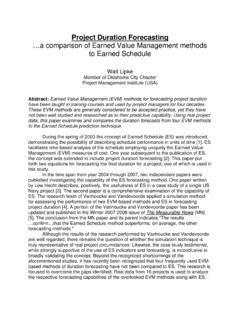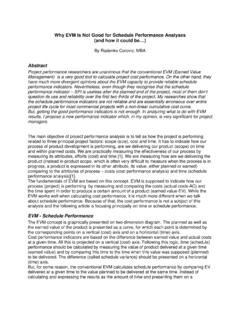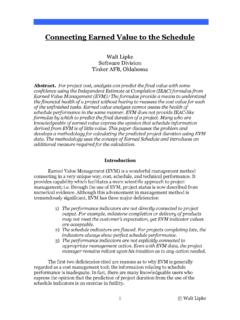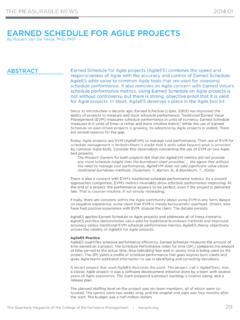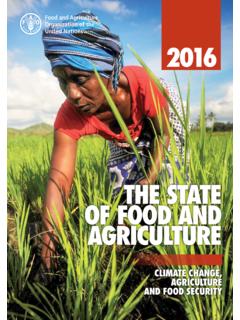Transcription of Why Should CPI = 1? - Earned Schedule
1 PM World Today March 2011 (Vol XIII, Issue III) PM World Today is a free monthly eJournal - Subscriptions available at Page 1 PM WORLD TODAY FEATURED PAPER MARCH 2011 Why Should CPI = 1? By Walt Lipke PMI Oklahoma City Chapter Abstract The expectation when applying Earned Value Management is to control performance such that CPI = This paper examines that premise. Two influences are identified: Schedule and risk. Each is shown to have negative impact on CPI. Recognizing how the influence is exhibited, an alternative management approach is proposed. Introduction I have wondered from time to time if those who use Earned Value Management (EVM) [PMI, 2005] Should rightfully expect the Cost Performance Index (CPI)a to have a value near or equal to Presently project managers (PM) applying EVM desire to guide cost performance such that CPI approaches Likewise, those who receive and analyze periodic project status reports examine with a reference of CPI = When the value is lower than the specified threshold (for example, CPIT = ), an explanation and a planned action for performance improvement is expected as part of the status review.
2 Briefly, this is the EVM system for project cost control. It is the accepted practice. Nevertheless my question remains, Is CPI = a reasonable expectation? Commonly during project execution, when the CPI value has been below the specified threshold for an extended time and efforts to cause improvement have not been successful, the PM will request approval to re-baseline the project. By gaining approval from the customer for the re-baseline, the pressure to improve performance is relieved. At least momentarily, the subsequent periodic status reports become acceptable; the CPI threshold has the appearance of not being breached. This practice diminishes the effectiveness of the EVM methodology for managing the current project and utilizing the measures for future project planning and evaluation of process improvement initiatives. If EVM practitioners could view CPI with an expectation a The CPI = EV / AC, where EV is the Earned Value and AC is the Actual Cost.
3 PM World Today March 2011 (Vol XIII, Issue III) PM World Today is a free monthly eJournal - Subscriptions available at Page 2 other than , it may be possible to minimize revising project baselines, thereby preserving project performance history. Additionally, management decisions and corrective actions may improve, as well, with an increased understanding of performance expectations. The objective of this paper is to examine the influences on CPI and propose an analysis/control alternative that improves project management with EVM. CPI and Schedule Let us begin with the project plan. During the planning, the potential negative risks are identified and evaluated and the resource loaded Schedule is created. Both of these areas will be shown to have negative impact on the expectation for CPI. Several years ago I realized that (especially for small projects) the resource loaded Schedule may have gaps, potentially causing some of the project personnel to not be fully utilized.
4 For example, let us assume the project Schedule requires twelve engineers. However, during a two week period, the project only needs ten. Shouldn t this difference affect the expectation for CPI? Unless two engineers are pooled and shared with another project, they are planned to accrue cost and not have planned value (PV) available to be Earned . With this condition known from the outset, the resource cost derived from the planned Schedule would be greater than the potential Earned value (EV) and thus the expectation for CPI would be a value less than Although not the focus in this discussion, the cost performance efficiency (CPIS) derived from the resource loaded Schedule could be used as a measure of scheduling effectiveness. The skills gaps could be evaluated and minimized to create a more efficient and cost effective Schedule , indicated by a value of CPIS closer to The value of CPIS, when the Schedule is finalized and the project commences, determines the planned cost performance efficiency.
5 This cost performance expectation has a maximum value of The inefficiency from the Schedule gaps affects the Management Reserve (MR)b [Humphreys, 2002] needed. The amount of MR to compensate for the gaps is calculable using the following equation: MRS = BAC (CPIS 1 1) where BAC is the Budget at Completion [PMI , 2005]. CPI and Risk Over the years there have been initiatives and efforts made to couple EVM and Risk Management (RM). Some of them are identified here for reference. About five years ago, the NDIA produced survey results indicating there is a strong desire within the b MR is the portion of the project budget that addresses inefficient performance and the negative risk. PM World Today March 2011 (Vol XIII, Issue III) PM World Today is a free monthly eJournal - Subscriptions available at Page 3 EVM community to integrate the two methodologies [NDIA, 2005].
6 At the 2006 International Integrated Program Management Conference (IPMC) a presentation was made which described the Northrop Grumman EVM and RM process [Tisone, 2006]. A paper published by David Hillson in 2004 developed a method which connected EVM performance to risk management reactions [Hillson, 2004]. In 2007, again at the IPMC, a presentation was made describing an approach to interfacing EVM and RM [Bone, 2007]. One connection between the two management methods is the risk evaluation for a project Should directly relate to the creation of its EVM Management Reserve (MR). The MR is intended during project execution to fund the effort needed to mitigate the impact of a risk Should it occur. Although the other references identified above imply this connection, only the presentation by Bone explicitly shows the relationship between risk evaluation and the EVM mechanism for risk handling. The Bone presentation describes a probabilistic approach to understanding exposure to risk.
7 The outcome of the method is the Performance Measurement Baseline (PMB)c along with the MR and the Schedule reserve. Although the method illustrates the exposure to risk it does not appear quantified in a way management can easily comprehend for decision making. A calculation method is available which could be used to augment the Bone method. This supplemental calculation produces the probability of having a successful project outcome given the amount of the budget allocated to MR and the risk evaluation in terms of cost performance variation [Lipke, 2009]. Having the probability of success enhances the decision choice for selection of the PMB and MR from the Bone process. An observation from the Bone presentation is that the potential risks are categorized into two areas, known and unknown. For the known category, the method recommends that plans be created and put into action upon occurrence of the specific risk to mitigate impact.
8 The risk action integrates with EVM by removing the necessary funding from MR, merging the risk mitigation plan with the PMB, thereby increasing the BAC and lengthening the project duration (removing a portion of the Schedule reserve, as well). Thus, the risk action can be tracked and managed, along with the remainder of the project, using EVM methods. Presumably the unknown risks are to be handled using the same process with the exception that before action takes place the mitigation is planned. For this instance, some amount of the MR budget is allocated and made available for planning. Depending upon the size of the action, management may choose to not integrate the mitigation plan with the PMB, but instead perform the necessary work using a portion of the available MR. c PMB is the time phased planned value from the resource loaded Schedule .
9 See [Humphreys, 2002]. PM World Today March 2011 (Vol XIII, Issue III) PM World Today is a free monthly eJournal - Subscriptions available at Page 4 Possibly, you can begin to see instances where it is problematic to simultaneously handle risk and expect CPI = What happens to CPI when unknown risks occur? In the previous paragraph it was stated that MR is consumed and the action may not be integrated with the PMB. In this instance, for both the planning and the mitigation action, the project incurs the cost but no EV is accrued. When this occurs, CPI Should be expected to decrease and become a poorer value. It follows then that the present EVM method of control using a set threshold is very likely causing unnecessary management actions and project re-baselines. Analysis of Risk Impact on CPI From the Bone presentation, the distribution of possible project outcomes was illustrated to be right-skewed, for both the cost and time The distribution is caused by the uncertainty of the occurrence of the risks.
10 Logically extrapolating, it is my hypothesis that the impact of project risks is related to the present status of the project. That is, the risk impact distribution is right skewed with respect to the percentage completion of the project. As an example, the impact of risk increases from zero to a peak at 35 percent complete, then becomes smaller and smaller as the project progresses, and is equal to zero at project completion. Succinctly, the rationale for this risk distribution is that impacts are likely to appear in relationship to specific dependent activities in the Schedule . As the project progresses, the number of dependent activities increase to a point and then decrease until project Assuming the risk distribution follows the hypothesized description, the MR applied to risk mitigation reflects the cumulative impacts. As described previously, when a risk occurs, its pre-planned mitigation can be integrated with the existing PMB.


